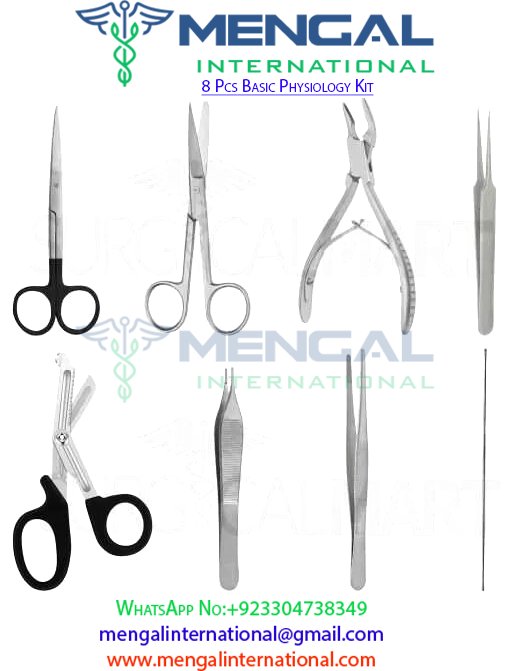Basic Physiology Kit
Basic physiology surgery and dissecting kit contains 8 instruments useful in a variety of procedures. Physiology plays a very important role in health professions, Doctors, Nurses, and Medical professionals need extensive knowledge of physiology in order to properly serve their patients. Pharmacists also need thorough knowledge in physiology so that they can better understand the effect of drug interactions with the body’s organ systems.
Our Physiology Kit contains instruments to perform dissection and understand Physiology. All tools are made of Surgical grade stainless steel, used by professionals.
BASIC PHYSIOLOGY KIT INCLUDES
- 1 Super Cut Iris Scissors 11cm
- 1 Dissection Scissors 14cm Sharp/Blunt
- 1 Freidman Bone Rongeurs 15cm 2mm
- 1 Micro Forceps #5 11.5cm
- 1 Probe Blunt 1mm 15cm
- 1 EMT Scissors 15cm
- 1 Adson Micro Forceps 12cm
- 1 Dressing Forceps 16cm
TECHNICAL INFORMATION:
APPLICATION: Physiology Surgical and Dissecting Procedure
Description
A basic physiology kit is a collection of instruments and tools used in educational settings, laboratories, and sometimes clinical environments to demonstrate and study physiological principles and experiments. These kits are essential for students, researchers, and educators in the fields of biology, physiology, medicine, and related disciplines. Here’s a detailed overview of the components typically found in a basic physiology kit:
Basic Components:
- Stethoscope: Used to auscultate (listen to) sounds within the body, particularly heart sounds, lung sounds, and blood flow in arteries and veins.
- Sphygmomanometer (Blood Pressure Cuff): Used to measure blood pressure non-invasively. It includes a cuff, a pressure meter (manometer), and a bulb for inflation.
- Ophthalmoscope: Used to examine the interior structures of the eye, including the retina, optic disc, and blood vessels.
- Otoscope: Used to examine the external ear canal and tympanic membrane (eardrum).
- Tuning Fork: Used for testing hearing acuity (Rinne and Weber tests) and for assessing vibration sensitivity in neurological exams.
- Reflex Hammer (Taylor Hammer): Used to test deep tendon reflexes, such as the knee jerk reflex (patellar reflex).
- Pulse Oximeter: Measures oxygen saturation in the blood (SpO2) and pulse rate. It typically clips onto a finger or earlobe.
- Thermometer: Used to measure body temperature. Types include digital, mercury (less common due to safety concerns), and infrared (non-contact).
- Goniometer: Used to measure joint angles, particularly in assessing range of motion in joints.
- Tape Measure: Used for anthropometric measurements, such as height and circumference of body parts.
- Calipers: Used for precise measurement of small distances, such as skinfold thickness in body composition analysis.
- Stopwatch: Used to measure time intervals in physiological experiments and tests, such as heart rate recovery after exercise.
Additional Instruments and Supplies:
- Gloves and Masks: Personal protective equipment (PPE) used during examinations or when handling bodily fluids.
- Cotton Balls and Gauze: Used for wound care or applying pressure.
- Disposal Containers: For safe disposal of used needles, swabs, and other medical waste.
Applications and Educational Use:
- Demonstrative Purposes: Kits are used to demonstrate physiological concepts and principles in educational settings, helping students understand bodily functions and responses.
- Clinical Skills Training: Medical and nursing students use these kits to practice clinical examination techniques, such as taking blood pressure or auscultating heart sounds.
- Research: Researchers use these kits for basic physiological measurements in studies investigating human health and disease.
- Health Screenings: Some components, like blood pressure cuffs and pulse oximeters, are used in community health screenings to monitor vital signs.
Sterilization and Maintenance:
- Instruments should be cleaned and sterilized according to standard procedures after each use to prevent cross-contamination and ensure patient safety.
- Regular maintenance and calibration of instruments (e.g., sphygmomanometer, pulse oximeter) are necessary to ensure accuracy and reliability.
Conclusion:
A basic physiology kit is indispensable for teaching, learning, and conducting basic physiological assessments. These kits provide essential tools for understanding human anatomy and function, practicing clinical skills, and conducting research in various fields of healthcare and biological sciences. Proper use, maintenance, and sterilization of the instruments are crucial to uphold safety standards and ensure accurate results in physiological assessments and educational demonstrations.






Reviews
There are no reviews yet.